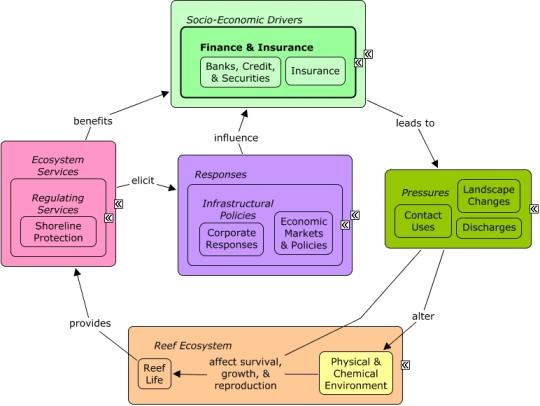ReefLink Database

Banks, Credit, & Securities
Banks, Credit, and Securities are subsectors primarily engaged in financial transactions, including raising funds, making loans, and purchasing securities.
CMap

CMap Description
The Finance and Insurance sector can drive coastal development and contribute to landscape changes, including impervious surfaces, which alter rates of pollutant runoff, or to the need for physical changes to the coastline, such as shoreline armoring. Financial centers benefit from shoreline protection, particularly insurance companies, which are concerned with flood damage or erosion that put property and human lives at risk. Financial sectors also benefit indirectly from other ecosystem services that improve the well-being of sectors, such as tourism & recreation, which drive the overall economy. Corporate decisions and economic markets can influence how financial sectors distribute finances and set insurance rates.Citations
More than 50 citations. Click here to load.
| Citation | Year | Study Location | Study Type | Database Topics |
|---|
Management Options
| Management Option | Description | Sources | Database Topics |
|---|---|---|---|
| Agriculture & Aquaculture: Phase Out Unwanted Subsidies | Subsidies are often offered to promote certain types of growth and development. At a later time, with changing priorities, it may be determined that these types of growth and development are no longer optimal. For example, sun grown coffee, was subsidized in Guancia Bay, PR, as it was expected to have higher future market demand. However, it requires clearing large tracts of land on steep, extremely erodible clay soils. This leads to high volumes of erosion because there is no vegetation to anchor the soil in place. Now these subsidies are promoting sun grown coffee even though shade grown is better for the land and reefs because it reduces erosion, extreme runoff, and adds vegetation to the land. | Center for Watershed Protection. 2008. Guanica Bay watershed management plan. |
Agriculture; Agriculture, Aquaculture, & Forestry Policies; Banks, Credit, & Securities; City Planning; Corporate Responses; Decision Support; Economic Markets & Policies; Finance & Insurance; Food & Energy Policies; Food & Raw Materials; Funding & Incentives; Infrastructural Policies; Infrastructure; Landuse Management; Political Pressure; Public Administration; Security; Security & Public Administration Policies |
| Corporate Response: Standardized Environmental Certifications and Labels | Product labeling initiatives are based on the premise that product information represented by or contained on the label is otherwise not readily available (or apparent) and is of value in consumer purchase decisions. For example, warning labels highlight product safety and toxic exposure hazards and advise consumers on ways to minimize risks. Likewise, a number of environmental certification programs (ECPs) identify products' environmental burdens and/or set standards for products' environmental attributes. Properly designed environmental labeling efforts can change consumer and manufacturer attitudes and behaviors, thus reducing environmental burdens. The specific metrics used to measure environmental label effectiveness include: 1) consumer awareness of labels, 2) consumer acceptance of labels (credibility and understanding), 3) changes in consumer behavior, 4) changes in manufacturer behavior, and 5) improvement of end goals, such as environmental quality. | Malcohn, E., Bentham Paulos, Andrew Stoeckle, Herbert Han-Pu Wang, and Julie Lynch. Determinants of Effectiveness for Environmental Certification and Labeling Programs. EPA-742-R-94-001, US EPA, Washington, DC. |
Agriculture; Agriculture, Aquaculture, & Forestry Policies; Aquaculture; Banks, Credit, & Securities; Climate; CO2; Collaboration & Partnering; Commercial Fisheries; Corporate Responses; Economic Markets & Policies; Environmental Education & Outreach; Fishing Sector; Food & Energy Policies; Food, Beverage, & Tobacco Products; Forestry; Health; Manufacturing & Trade; Manufacturing & Trade Policies; Marine Birds; Medical Care; Medical Centers; Metals, Electronics, & Machinery Products; Resource Use Management; Toxics; Transportation; Utilities; Whales & Dolphins; Wholesale & Retail Trade; Wood, Plastics, & Chemical Products |
| Corporate Response: Invest & Co-finance Projects | Investing and co-financing projects that aim to conserve or restore habitats can be an effective means to preserving reef habitats as well as establishing positive working relationships between organizations. Investing in private sector projects will promote desired businesses and business practices, reducing barriers to entry and competitiveness as compared to traditional businesses and business practices to counterbalance advantages from undesired externalities. | World Bank Group. 2008. Biodiversity, Climate Change, and Adaptation. Nature based solutions from the world bank portfolio. The International Bank for Reconstruction and Development, Washington, DC. |
Aquarium Stock; Banks, Credit, & Securities; Biochemical & Genetic Resources; Biomedical Research Policies; Collaboration & Partnering; Corporate Responses; Economic Markets & Policies; Finance & Insurance; Finfish & Shellfish Stock; Food & Raw Materials; Funding & Donations; Funding & Incentives; Manufacturing & Trade; Manufacturing & Trade Policies; Marine Products; Ornamental Jewelry & Art; Pharmaceuticals & Cosmetics Sources; Provisioning Services; Resource Use Management; Tourism & Recreation |
Laws
| Legal Citation | Purpose of Law | Management Organization | Database Topics |
|---|
